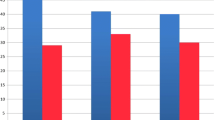Abstract
The study design includes prospective evaluation of percutaneous osteosynthesis associated with cement kyphoplasty on 18 patients. The objective of the study is to assess the efficacy of a percutaneous method of treating burst vertebral fractures in patients without neurological deficits. Even if burst fractures are frequent, no therapeutic agreement is available at the moment. We report in this study the results at 2 years with a percutaneous approach for the treatment of burst fractures. 18 patients were included in this study. All the patients had burst vertebral fractures classified type A3 on the Magerl scale, between levels T9 and L2. The patients’ mean age was 53 years (range 22–78 years) and the neurological examination was normal. A percutaneous approach was systematically used and a kyphoplasty was performed via the transpedicular pathway associated with percutaneous short-segment pedicle screw osteosynthesis. The patients’ follow-up included CT scan analysis, measurement of vertebral height recovery and local kyphosis, and clinical pain assessments. With this surgical approach, the mean vertebral height was improved by 25% and a mean improvement of 11.28° in the local kyphotic angle was obtained. 3 months after the operation, none of the patients were taking class II analgesics. The mean duration of their hospital stay was 4.5 days (range 3–7 days) and the mean follow-up period was 26 months (range 17–30 months). No significant changes in the results obtained were observed at the end of the follow-up period. Minimally invasive methods of treating burst vertebral fractures can be performed via the percutaneous pathway. This approach gives similar vertebral height recovery and kyphosis correction rates to those obtained with open surgery. It provides a short hospital stay, however, and might therefore constitute a useful alternative to open surgical methods.





Similar content being viewed by others
References
Magerl F, Aebi M, Gertzbein SD, Harms J, Nazarian S (1994) A comprehensive classification of thoracic and lumbar injuries. Eur Spine J 3:184–201
Been HD, Bouma GJ (1999) Comparison of two types of surgery for thoraco-lumbar burst fractures: combined anterior and posterior stabilisation vs. posterior instrumentation only. Acta Neurochir (Wien) 141:349–357
Wood KB, Bohn D, Mehbod A (2005) Anterior versus posterior treatment of stable thoracolumbar burst fractures without neurologic deficit: a prospective, randomized study. J Spinal Disord Tech 18(Suppl):S15–S23
Richter-Turtur M, Krueger P, Stephan F, Mandelkow H, Sauer T (1990) Expanded trans-pedicular spongiosa grafting–dorsal approach to filling of the intervertebral spaces with cancellous bone. Unfallchirurg 93:387–389
Okuyama K, Abe E, Chiba M, Ishikawa N, Sato K (1996) Outcome of anterior decompression and stabilization for thoracolumbar unstable burst fractures in the absence of neurologic deficits. Spine 21:620–625
Maestretti G, Cremer C, Otten P, Jakob RP (2007) Prospective study of standalone balloon kyphoplasty with calcium phosphate cement augmentation in traumatic fractures. Eur Spine J 16:601–610
Cho DY, Lee WY, Sheu PC (2003) Treatment of thoracolumbar burst fractures with polymethyl methacrylate vertebroplasty and short-segment pedicle screw fixation. Neurosurgery 53:1354–1360 (discussion: 1360–1361)
Verlaan JJ, Dhert WJ, Verbout AJ, Oner FC (2005) Balloon vertebroplasty in combination with pedicle screw instrumentation: a novel technique to treat thoracic and lumbar burst fractures. Spine (Phila Pa 1976) 30:E73–E79
Afzal S, Akbar S, Dhar SA (2008) Short segment pedicle screw instrumentation and augmentation vertebroplasty in lumbar burst fractures: an experience. Eur Spine J 17:336–341
Acosta FL Jr, Aryan HE, Taylor WR, Ames CP (2005) Kyphoplasty-augmented short-segment pedicle screw fixation of traumatic lumbar burst fractures: initial clinical experience and literature review. Neurosurg Focus 18:e9
Thomas KC, Bailey CS, Dvorak MF, Kwon B, Fisher C (2006) Comparison of operative and nonoperative treatment for thoracolumbar burst fractures in patients without neurological deficit: a systematic review. J Neurosurg Spine 4:351–358
Chen JF, Lee ST (2004) Percutaneous vertebroplasty for treatment of thoracolumbar spine bursting fracture. Surg Neurol 62:494–500
Ryu KS, Park CK, Kim MC, Kang JK (2002) Dose-dependent epidural leakage of polymethylmethacrylate after percutaneous vertebroplasty in patients with osteoporotic vertebral compression fractures. J Neurosurg 96:56–61
Fourney DR, Schomer DF, Nader R, Chlan-Fourney J, Suki D, Ahrar K, Rhines LD, Gokaslan ZL (2003) Percutaneous vertebroplasty and kyphoplasty for painful vertebral body fractures in cancer patients. J Neurosurg 98:21–30
Atalay B, Caner H, Gokce C, Altinors N (2005) Kyphoplasty: 2 years of experience in a neurosurgery department. Surg Neurol 64(Suppl 2):S72–S76
Foley KT, Gupta SK, Justis JR, Sherman MC (2001) Percutaneous pedicle screw fixation of the lumbar spine. Neurosurg Focus 10:E10
Palmisani M, Gasbarrini A, Brodano GB, De Iure F, Cappuccio M, Boriani L, Amendola L, Boriani S (2009) Minimally invasive percutaneous fixation in the treatment of thoracic and lumbar spine fractures. Eur Spine J 18(Suppl 1):71–74
Uchida K, Kobayashi S, Matsuzaki M, Nakajima H, Shimada S, Yayama T, Sato R, Baba H (2006) Anterior versus posterior surgery for osteoporotic vertebral collapse with neurological deficit in the thoracolumbar spine. Eur Spine J 15:1759–1767
Majd ME, Farley S, Holt RT (2005) Preliminary outcomes and efficacy of the first 360 consecutive kyphoplasties for the treatment of painful osteoporotic vertebral compression fractures. Spine J 5:244–255
Voggenreiter G (2005) Balloon kyphoplasty is effective in deformity correction of osteoporotic vertebral compression fractures. Spine 30:2806–2812
Author information
Authors and Affiliations
Corresponding author
Rights and permissions
About this article
Cite this article
Fuentes, S., Blondel, B., Metellus, P. et al. Percutaneous kyphoplasty and pedicle screw fixation for the management of thoraco-lumbar burst fractures. Eur Spine J 19, 1281–1287 (2010). https://doi.org/10.1007/s00586-010-1444-4
Received:
Revised:
Accepted:
Published:
Issue Date:
DOI: https://doi.org/10.1007/s00586-010-1444-4




